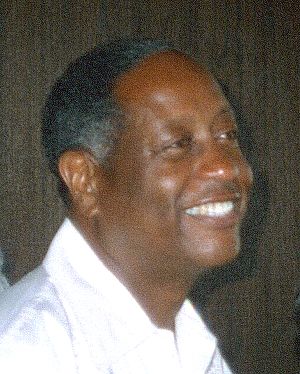Nathan Pitts facts for kids
Quick facts for kids
Nathan Pitts
|
|
|---|---|

Dr. Nathan A. Pitts
|
|
| Born | June 29, 1913 |
| Died | June 15, 1998 Baltimore, Maryland
|
| Occupation | United States Office of Education: United Nations Education, Scientific and Cultural Organization |
Nathan Alvin Pitts (June 29, 1913 – June 15, 1998) was an important African-American leader. He worked for the U.S. government, helped other countries as a diplomat, and gave back to his community. He retired in 1980 from the Department of Education, where he was in charge of international education. From 1970 to 1975, he was the first African American to represent the U.S. in education matters at UNESCO (a part of the United Nations).
Contents
Early Life and Education
Nathan Pitts was born on June 29, 1913. He was the youngest of four brothers.
Nathan went to Florida A&M University and Xavier University. He played football and basketball on scholarships. He earned his degree from Xavier in 1936. In 1935-36, he was recognized as an All-American Quarterback for Xavier. His football coach, Theodore A. (Ted) Wright, was a big help to him.
After college, Coach Wright helped Nathan find a job. He became a coach and teacher at Immaculata High School in Birmingham, Alabama. There, his track and basketball teams won many awards.
Career Highlights
Coach Wright later helped Nathan become a principal and main teacher. This was at the Cardinal Gibbons Institute in St. Mary's County, Maryland. He worked there from 1938 to 1944. Nathan's wife, Mary Williams Pitts, also taught at the school. She taught home economics. They had met when they were both students at Florida A&M.
The school was a Catholic mission. It was overseen by Father Horace McKenna. He was a famous activist priest. Father McKenna later started charities like So Others Might Eat.
Helping Communities
While at Cardinal Gibbons, Nathan and Father McKenna worked to help local communities. They helped Black fishermen and farmers start credit unions and cooperatives. These groups helped people work together and share resources. This work gave Nathan an idea for his advanced degrees. He earned his Masters and PhD from Catholic University in Washington, D.C. His studies focused on how cooperative groups helped Black communities in the countryside.
A novel called Dearly Beloved by Harry Sylvester was inspired by the work of Father McKenna and Dr. Pitts in St. Mary's County.
Teaching and Government Work
Before joining the U.S. government in 1961, Dr. Pitts was a professor. He led the social science department at Coppin State Teachers College in Baltimore, Maryland. Before that, he taught at several other colleges. These included North Carolina College for Negros in Durham, North Carolina, Shaw University in Raleigh, North Carolina, and South Carolina State College in Orangeburg, South Carolina.
While Nathan taught at Shaw University, one of his students was Angie Brooks. She later became a diplomat from Liberia. She was also the first African woman to be elected President of the United Nations General Assembly. Nathan and Angie met again in 1970. They were both serving their countries as diplomats at the United Nations.
International Education Work
From 1957 to 1959, Nathan took a break from teaching. He worked in Tehran and Azerbaijan Province in Iran. This was with the State Department's International Cooperation Administration (ICA). When he came back to the U.S., he left his teaching job. He then started working for the U.S. Office of Education's Education Division in 1961.
He became the Chief of International Organizations Recruitment. In this role, he helped the Office of Education work with the ICA program. He also connected the Office of Education with the Department of State. He created a full-time position for the Office of Education within the U.S. Delegation to UNESCO. Then, in 1970, Nathan himself took on this important role. He worked for the U.S. Delegation to UNESCO until 1975.
After returning to Washington, D.C. in 1975, he became the Chief of the International Exchange Branch. He held this title until he retired in 1980.
Retirement and Legacy
After retiring, Nathan Pitts became an activist for education reform. He worked in northwest Baltimore, Maryland. He passed away in Baltimore on June 15, 1998.
To honor his work, a school in Baltimore was named after him. The Dr. Nathan A. Pitts-Ashburton Elementary/Middle School was named to recognize his efforts. He worked hard to improve education in inner-city areas.

